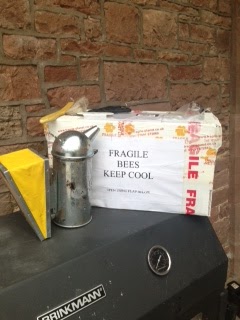 |
| WHAT'S INSIDE THE BOX? The clue is in picture as my postman pointed out |
AT LAST! My much awaited colony of Buckfast bees arrived today via the postman who did not share my enthusiasm as he asked me to sign for the parcel.
'You'll never guess what's inside,' I said but he replied dryly: 'Bees, and they don't sound happy,' as he passed the parcel. OK, so it was marked 'BEES' in large letters but he could've indulged me. The occupants were indeed buzzing very, very loudly and even the box was vibrating.
I knew I should wait, may be keep them stored overnight until my other half arrived to help me unload our honeybees into their hive but patience is not a virtue of mine. It was also proving to be an incredibly hot day and I thought the last thing the newbys would want was to spend another day in a box.
So I swung into action and got the smoker going, donned my white beekeeper's outfit and prepared the hive for the noisy Buckfasts.
For those interested, this type of bee was developed by a German-born monk called Brother Adam (1898-1996) who kept bees at Buckfast Abbey in Devon. After huge numbers of the British black bee were wiped out in the second decade of the last century due to an epidemic of acarine disease he set about trying to breed a special strain of resistant bees. At Buckfast the only colonies not affected by the disease were those headed by Ligurian queens and hybrids of these queens with British black bees.
Brother Adam's lifelong quest to breed a strain of honey bee that would contain as many desirable qualities as possible for beekeepers is carried on today by his followers and beekeepers across Europe. In order to do this however, it was necessary to be able to control the mating of the selected queens with selected drones and thus a mating station at a remote spot on Dartmoor was established in 1925, this was in continual use until the mid 1990’s. There is a Buckfast club and more details can be had here: http://www.buckfastbeekeepersgroup.co.uk/
As I bent down to open the box it suddenly occurred to me these little fellas would not be in the same party mode as the chillaxed Ayshire swarm we handled about 10 days ago ... swarm bees are usually full of honey and their bodies so bloated they can't physically sting you even if they wanted. Also all that honey has a pacifying effect but this colony didn't sound happy at all.
After saying a little prayer I opened the lid to reveal five frames which I then gently placed inside the hive. The Warré (pronounced war-ray) is supposed to be simple to manage and maintain and was designed by some French bloke called Emile Warré (1867-1951). After experimenting with 350 different types of hives he came up with the Warré and called it the Peoples' Hive. It's supposed to be popular with bees as well since they are allowed to draw out their own comb. New hive boxes are added to the bottom and not the top of the hive which encourages the bees natural tendency to build down ensuring an environment that is healthier and better suited to their own needs. That's the theory, anyway.
The last thing I wanted to do was go back into the hive and start searching around for the Queen.
As I returned back to base, cussing myself along the way, I found an envelope which must have slipped from the box as I ripped away the sticky tape and excess paper ... it contained the instructions of what to do with the new colony. Suffice to say what I did bore little resemblance to the list of dos and donts but at least the end result was the same ... the bees are in the hive and several checks until late this evening revealed they were doing what busy bees do, as you can see from my short video.
How long will these colonies take to prepare the requisite honey ?
ReplyDeleteCongratulations, for the bees. About your profile, it's great. My parents moved to their homestead in Canada and lived there for years, I never thought they would stay that long. We used to visit with our kids on weekends, or during a week off in summer when we moved to Montreal and then Ottawa and a few other places. Now my parents are older and live in the city again, but lots of fond memories of life on the "homestead", they even got interviewed for the 'lifestyle' section of their local paper.
ReplyDelete